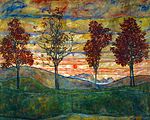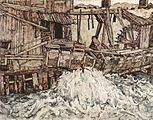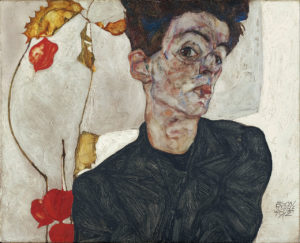 On this day in 1918, painter Egon Schiele died from the Spanish Flu in Vienna, three days after his wife Edith, at the age of 28. Born on 12 June 1890 in Tulln, Lower Austria. A protégé of Gustav Klimt, Schiele was a major figurative painter of the early 20th century. His work is noted for its intensity and its raw sexuality, and the many self-portraits the artist produced, including naked self-portraits. The twisted body shapes and the expressive line that characterize Schiele’s paintings and drawings mark the artist as an early exponent of Expressionism.
On this day in 1918, painter Egon Schiele died from the Spanish Flu in Vienna, three days after his wife Edith, at the age of 28. Born on 12 June 1890 in Tulln, Lower Austria. A protégé of Gustav Klimt, Schiele was a major figurative painter of the early 20th century. His work is noted for its intensity and its raw sexuality, and the many self-portraits the artist produced, including naked self-portraits. The twisted body shapes and the expressive line that characterize Schiele’s paintings and drawings mark the artist as an early exponent of Expressionism.
In 1911, Schiele met the seventeen-year-old Walburga (Wally) Neuzil, who lived with him in Vienna and served as a model for some of his most striking paintings. Very little is known of her, except that she had previously modelled for Klimt and might have been one of his mistresses. Schiele and Wally wanted to escape what they perceived as the claustrophobic Viennese milieu, and went to the small town of Český Krumlov (Krumau) in southern Bohemia. Krumau was the birthplace of Schiele’s mother; today it is the site of a museum dedicated to Schiele. Despite Schiele’s family connections in Krumau, he and his lover were driven out of the town by the residents, who strongly disapproved of their lifestyle, including his alleged employment of the town’s teenage girls as models.
Together they moved to Neulengbach, 35 km west of Vienna, seeking inspirational surroundings and an inexpensive studio in which to work. As it was in the capital, Schiele’s studio became a gathering place for Neulengbach’s delinquent children. Schiele’s way of life aroused much animosity among the town’s inhabitants, and in April 1912 he was arrested for seducing a young girl below the age of consent.
When the police came to his studio to place him under arrest, they seized more than a hundred drawings which they considered pornographic. Schiele was imprisoned while awaiting his trial. When his case was brought before a judge, the charges of seduction and abduction were dropped, but the artist was found guilty of exhibiting erotic drawings in a place accessible to children. In court, the judge burned one of the offending drawings over a candle flame. The twenty-one days he had already spent in custody were taken into account, and he was sentenced to a further three days’ imprisonment. While in prison, Schiele created a series of 12 paintings depicting the difficulties and discomfort of being locked in a jail cell.
In 1914, Schiele glimpsed the sisters Edith and Adéle Harms, who lived with their parents across the street from his studio in the Viennese district of Hietzing, 101 Hietzinger Hauptstraße. They were a middle-class family and Protestant by faith; their father was a master locksmith. In 1915, Schiele chose to marry the more socially acceptable Edith, but had apparently expected to maintain a relationship with Wally. However, when he explained the situation to Wally, she left him immediately and never saw him again. This abandonment led him to paint Death and the Maiden, where Wally’s portrait is based on a previous pairing, but Schiele’s is newly struck. (In February 1915, Schiele wrote a note to his friend Arthur Roessler stating: “I intend to get married, advantageously. Not to Wally.”) Despite some opposition from the Harms family, Schiele and Edith were married on 17 June 1915, the anniversary of the wedding of Schiele’s parents.
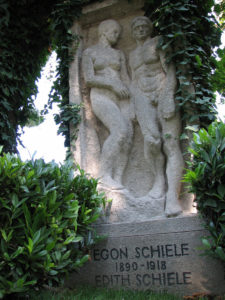 The Final Footprint
The Final Footprint
In the autumn of 1918, the Spanish flu pandemic that claimed more than 20,000,000 lives in Europe reached Vienna. Edith, who was six months pregnant, succumbed to the disease on 28 October. Schiele died only three days after his wife. He was 28 years old. During the three days between their deaths, Schiele drew a few sketches of Edith. They are interred together at Friedhof Ober Sankt Veit, Vienna.
Max Oppenheimer 1910
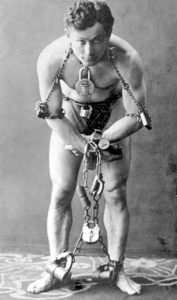 On this day in 1926, magician and escapologist, Harry Houdini died at Grace Hospital in Detroit, Michigan at the age of 52. Born Erik Weisz on 24 March 1874 in Budapest, Austria-Hungary. His family came to America in 1878 and settled in Wisconsin before moving to New York City. The family changed the spelling of their German surname to Weiss and changed the spelling of their son’s name to Ehrich. Friends called him Ehrie or Harry. He became a professional magician and began calling himself Harry Houdini, as he was heavily influenced by the French magician Jean Eugène Robert-Houdin. In 1893 he married Wilhelmina Beatrice (Bess) Rahner. Best known for his famous escape acts.
On this day in 1926, magician and escapologist, Harry Houdini died at Grace Hospital in Detroit, Michigan at the age of 52. Born Erik Weisz on 24 March 1874 in Budapest, Austria-Hungary. His family came to America in 1878 and settled in Wisconsin before moving to New York City. The family changed the spelling of their German surname to Weiss and changed the spelling of their son’s name to Ehrich. Friends called him Ehrie or Harry. He became a professional magician and began calling himself Harry Houdini, as he was heavily influenced by the French magician Jean Eugène Robert-Houdin. In 1893 he married Wilhelmina Beatrice (Bess) Rahner. Best known for his famous escape acts.
The Final Footprint – Houdini was buried in the the Houdini-Weiss Family Estate in Machpelah Cemetery in Queens, New York. 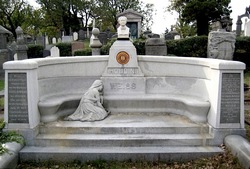 Every year on the anniversary of his death, Bess conducted a seance and tried to contact her husband’s spirit. After the tenth year she stopped, allegedly saying that ten years was long enough to wait for any man. Bess wished to be interred next to him but when she died her Catholic family refused to bury her in a Jewish cemetery.
Every year on the anniversary of his death, Bess conducted a seance and tried to contact her husband’s spirit. After the tenth year she stopped, allegedly saying that ten years was long enough to wait for any man. Bess wished to be interred next to him but when she died her Catholic family refused to bury her in a Jewish cemetery.
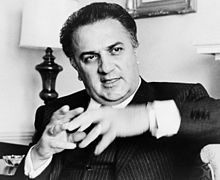 On this day in 1993, film director and screenwriter, Federico Fellini died from complications of a stroke in Rome at the age of 73, a day after his fiftieth wedding anniversary. Born 20 January 1920 in Rimini, Italy. Known for his distinct style that blends fantasy and baroque images with earthiness, in my opinion, he is one of the greatest and most influential filmmakers of the 20th century. In a career spanning almost fifty years, Fellini won five Academy Awards including the most Oscars in history for Best Foreign Language Film. Writing for radio, Fellini met his future wife Giulietta Masina in a studio office at the Italian public radio broadcaster EIAR in autumn 1942. Well-paid as the voice of Pallina in Fellini’s radio serial, Cico and Pallina, Masina was also well known for her musical-comedy broadcasts which cheered an audience depressed by the war. My favorite Fellini films include: La Strada (1954); Nights of Cabiria (Le notti di Cabiria) (1957); La Dolce Vita (1960); 8½ (Otto e mezzo) (1963); and Amarcord (1974).
On this day in 1993, film director and screenwriter, Federico Fellini died from complications of a stroke in Rome at the age of 73, a day after his fiftieth wedding anniversary. Born 20 January 1920 in Rimini, Italy. Known for his distinct style that blends fantasy and baroque images with earthiness, in my opinion, he is one of the greatest and most influential filmmakers of the 20th century. In a career spanning almost fifty years, Fellini won five Academy Awards including the most Oscars in history for Best Foreign Language Film. Writing for radio, Fellini met his future wife Giulietta Masina in a studio office at the Italian public radio broadcaster EIAR in autumn 1942. Well-paid as the voice of Pallina in Fellini’s radio serial, Cico and Pallina, Masina was also well known for her musical-comedy broadcasts which cheered an audience depressed by the war. My favorite Fellini films include: La Strada (1954); Nights of Cabiria (Le notti di Cabiria) (1957); La Dolce Vita (1960); 8½ (Otto e mezzo) (1963); and Amarcord (1974).
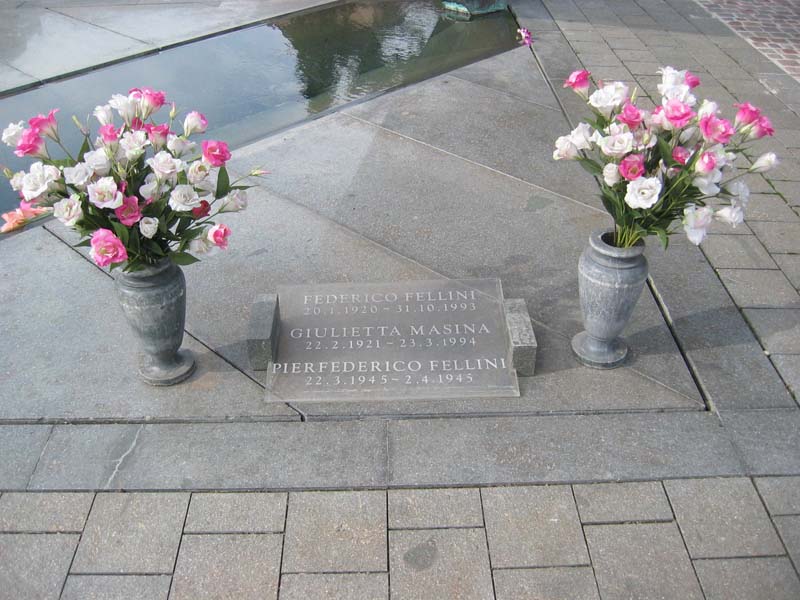 The Final Footprint – A memorial service was held in Studio 5 at Cinecittà. At the request of Masina, trumpeter Mauro Maur played the “Improvviso dell’Angelo” by Nino Rota during the funeral ceremony. Five months later on 23 March 1994, Masina died of lung cancer. Fellini, Masina and their son Pierfederico are entombed in a bronze sepulchre sculpted by Arnaldo Pomodoro. Designed as a ship’s prow, the tomb is located at the main entrance to the Cemetery of Rimini. The Federico Fellini Airport in Rimini is named in his honour.
The Final Footprint – A memorial service was held in Studio 5 at Cinecittà. At the request of Masina, trumpeter Mauro Maur played the “Improvviso dell’Angelo” by Nino Rota during the funeral ceremony. Five months later on 23 March 1994, Masina died of lung cancer. Fellini, Masina and their son Pierfederico are entombed in a bronze sepulchre sculpted by Arnaldo Pomodoro. Designed as a ship’s prow, the tomb is located at the main entrance to the Cemetery of Rimini. The Federico Fellini Airport in Rimini is named in his honour.
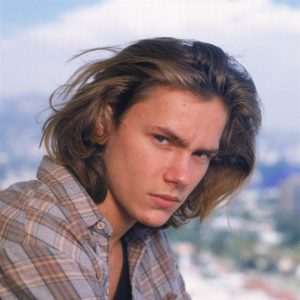 On this day in 1993 actor, musician, activist River Phoenix died from a drug overdose on the sidewalk outside the West Hollywood nightclub The Viper Room at the age of 23. Born River Jude Phoenix (né Bottom) on August 23, 1970 in Madras, Oregon. He was the older brother of Rain Phoenix, Joaquin Phoenix, Liberty Phoenix, and Summer Phoenix.
On this day in 1993 actor, musician, activist River Phoenix died from a drug overdose on the sidewalk outside the West Hollywood nightclub The Viper Room at the age of 23. Born River Jude Phoenix (né Bottom) on August 23, 1970 in Madras, Oregon. He was the older brother of Rain Phoenix, Joaquin Phoenix, Liberty Phoenix, and Summer Phoenix.
Phoenix’s work encompassed 24 films and television appearances, and his rise to fame led to his status as a “teen idol”. He began his acting career at age 10, in television commercials. He starred in the science fiction adventure film Explorers (1985), and had his first notable role in 1986’s Stand by Me, a coming-of-age film based on the novella The Body by Stephen King. Phoenix made a transition into more adult-oriented roles with Running on Empty (1988), playing the son of fugitive parents in a well-received performance that earned him a nomination for an Academy Award for Best Supporting Actor, and My Own Private Idaho (1991), playing a gay hustler in search of his estranged mother. For his performance in the latter, Phoenix garnered praise and won a Volpi Cup for Best Actor at the Venice Film Festival, along with Best Actor from the National Society of Film Critics.
The Final Footprint
Phoenix was cremated and his ashes were scattered at his family ranch in Micanopy, Florida.
#RIP #OTD in 1995 actress (The Omega Man, Klute, The New Centurions, Uptown Saturday Night, General Hospital, Tales from the Hood) Rosalind Cash died from cancer at Cedars-Sinai Medical Center in Los Angeles aged 56. Cremation
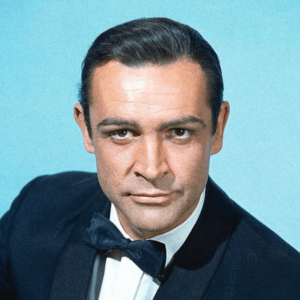 And on this day in 2020 actor Sean Connery died in his sleep at his home in Lyford Cay, Nassau in The Bahamas. Born Thomas Connery at the Royal Maternity Hospital in Edinburgh, Scotland, on 25 August 1930.
And on this day in 2020 actor Sean Connery died in his sleep at his home in Lyford Cay, Nassau in The Bahamas. Born Thomas Connery at the Royal Maternity Hospital in Edinburgh, Scotland, on 25 August 1930.
He was the first actor to portray fictional British secret agent James Bond on film, starring in seven Bond films between 1962 and 1983. Originating the role in Dr. No, Connery played Bond in six of Eon Productions’ entries and made his final appearance in Never Say Never Again. Following his third appearance as Bond in Goldfinger (1964), in June 1965 Time magazine observed “James Bond has developed into the biggest mass-cult hero of the decade”.
Connery began acting in smaller theatre and television productions until his breakout role as Bond. Although he did not enjoy the off-screen attention the role gave him, the success of the Bond films brought Connery offers from notable directors such as Alfred Hitchcock, Sidney Lumet and John Huston. Their films in which Connery appeared included Marnie (1964), The Hill (1965), Murder on the Orient Express (1974), and The Man Who Would Be King (1975). He also appeared in A Bridge Too Far (1977), Highlander (1986), The Name of the Rose (1986), The Untouchables (1987), Indiana Jones and the Last Crusade (1989), The Hunt for Red October (1990), Dragonheart (1996), The Rock (1996), and Finding Forrester (2000). Connery officially retired from acting in 2006.
His achievements in film were recognised with an Academy Award, two BAFTA Awards (including the BAFTA Fellowship), and three Golden Globes, including the Cecil B. DeMille Award and a Henrietta Award. In 1987, he was made a Commander of the Order of Arts and Letters in France, and he received the US Kennedy Center Honors lifetime achievement award in 1999. Connery was knighted in the 2000 New Year Honours for services to film drama.
The Final Footprint – Cremated remains scattered in The Bahamas and Scotland.
Have you planned yours yet?
Follow TFF on twitter @RIPTFF









































